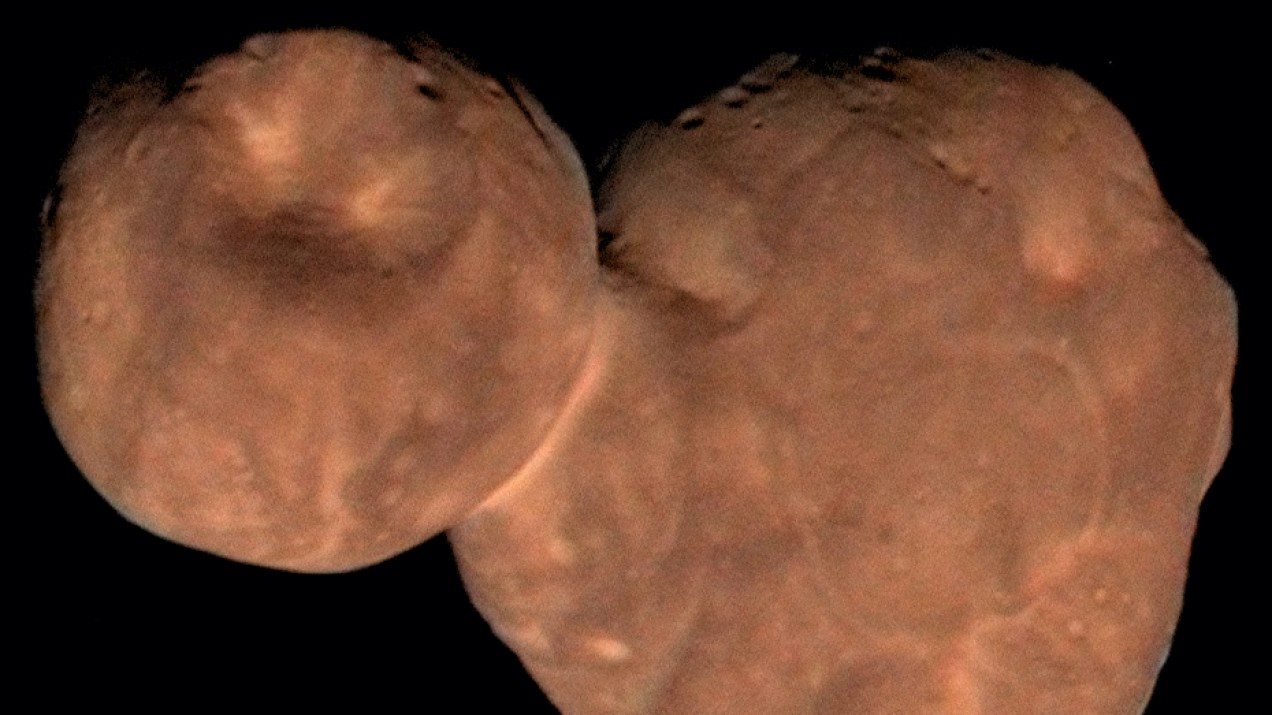


After NASA’s New Horizons probe successfully zipped past Pluto in 2015, a choice had to be made about where to go next. Scientists plumped for Arrokoth (formerly Ultima Thule), a strange, double-lobed red rock located about 4.1 billion miles from Earth.
What Arrokoth lacked in atmosphere and diverse geology, it made up for in the fact that it looks like a ridiculous cosmic snowman (end to end, it’s about 22 miles long, 12 miles wide, and 6 miles thick), partially flattened like a pair of pancakes. The bizarre structure makes for a very counterintuitive gravity field and rotation. “It doesn’t look like any other body we’ve ever seen,” says William McKinnon, a planetary scientist at Washington University in St. Louis.
The consensus now is that Arrokoth is much more interesting than scientists had initially thought. Its origin story may actually reflect how much of the solar system formed.
New Horizons flew by Arrokoth at over 31,500 miles per hour on New Year’s Day of last year. It came to within 2,200 miles of the rock. A trio of new studies published in Science on Thursday analyzes data gathered during the flyby to tell us how Arrokoth actually came into existence, and by extension how other planetesimals (minute building blocks for planets) in the solar system were born.
There have generally been two theories for how planetesimals come about. The first is called hierarchical accretion, where smaller objects crash into each other at high speed until they form something bigger. The second is local cloud collapse, where local concentrations of matter gravitationally collapse into one or more large building blocks, at low speeds.
The three studies each dive into different aspects of Arrokoth (one focuses on the object’s geology and geophysics, another on its material composition, and the last explores its probable formation). Taken together, however, they support local cloud collapse. “We’ve decisively solved a multi-decade debate about how planetesimals form,” says Alan Stern, a planetary scientist at the Southwest Research Institute and the lead for the New Horizons mission. The resolution of this debate, he says, “is not something we expected to come out of this mission—yet it seems incontrovertible.”
McKinnon and his team used the new data to run simulations that explored the most plausible models for Arrokoth’s formation, and those findings strongly supported this form of planetesimal evolution. They suggest that Arrokoth’s two segments formed independently from the collapse of the same cloud of material (hence the uniform red color).
Already in the same neighborhood, the bodies began to spend a lot of time in orbit of one another, eventually meeting up in a very gentle merger that probably happened at just a few miles per hour. “We think we have a really clean story for Arrokoth, but we don’t have any reason to think it’s unique,” says McKinnon. “We think this can be pretty neatly extrapolated to the rest of the solar system.”
The new studies also suggest that:
- The bodies are rounder than the initial images first led us to believe.
- The smooth surface, lacking in fractures and stressors, confirms the rock was formed at low speed.
- The number of craters suggests Arrokoth formed well over 4 billion years ago, when the solar system took shape.
- There are complex organic molecules on the surface (though we know now this is common for many objects in the solar system).
- There are traces of methanol ice on the surface, but in the surprising absence of water, it’s baffling how it got there.
It will take another year to completely download and analyze all the data New Horizons collected during its Arrokoth flyby. Meanwhile, Stern says, New Horizons is running in top health, with about one-eighth of its fuel remaining. It seems pretty likely the spacecraft has at least one more flyby left in it.
Over the next few summers, when observation conditions are optimal, the mission team will use some of the largest telescopes on Earth to figure out the most suitable targets for New Horizons to travel to. “We’re at the beginning of this process right now, and we’re really excited for what’s to come,” he says.